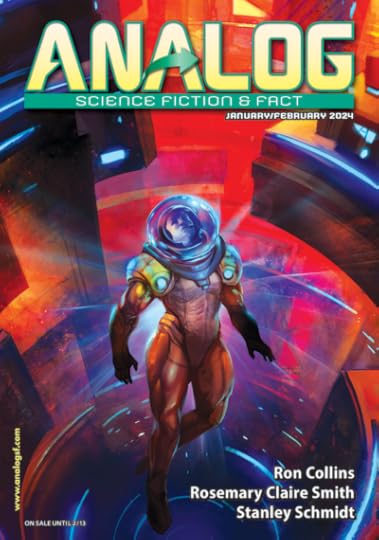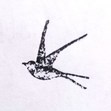Review – Analog Science Fiction & Fact, Jan/Feb 2024
Wow, it really has been a while since I wrote any proper book reviews, hasn’t it? The Riftwar Re-Read took it out of me. But what better way to start again than with something very recent, and relevant: the latest issue of Analog Science Fiction & Fact?

This is my first full issue of Analog, and it’s a pleasantly chunky thing, absolutely packed with content – 21 stories and poems of various lengths as well as 4 beefy factual pieces. I will confess that much of the hard science went straight over my head, though there were some interesting bits and pieces. New supercolliders! Microbial ‘soft cities’! Moon habitat stuff!
But I’m here for the sci-fi, so let’s get cracking on that.
As I just mentioned, 21 stories! Many were excellent, all were at least good, though some didn’t land so well for me. I’m not going to review every single one, and not in detail, but I thought I’d briefly go through some of my favourites. Because there were some great pieces in there.
‘Kagari’ by Ron Collins was a fantastic start to the magazine. We’re dropped, to my initial surprise and delight, straight into a fantasy story, where a society of medieval-ish bird-people are celebrating their prince’s coming of age, in a high mountain aerie overlooking the strange soil of an alien world. The prince, Rythane, is conflicted; his high position in a caste-based society is breaking his relationships and forcing him to grow up much too fast.
And then “a small, featherless creature”, “a wild avatar of the Sky Gods”, is brought to him, and Rythane begins to learn that the universe is a much bigger place than he had realised.
Collins conjures a beautiful world here. An alien culture of alien beings is deftly realised with barely any exposition, and Rythane is a genuinely sympathetic character. It’s a fine writer who can turn the ‘human explorer in an alien society’ trope on its head so well, and to make the token human character feel so alien in their own right, so well constructed is the rest of the world. A very good start indeed.
Next of note for me was ‘Homesick’ by H.A.B. Wilt, which takes the form of an interview with an astronaut in the wake of a Gravity-style orbital debris crisis. It’s a short piece, but elegant and highly emotional: this is an astronaut confronting the fact that she’s never going to be an astronaut again. But the optimism of it all regardless – the idea that the human drive to explore will never be fully quenched – was briefly, but beautifully, presented.
In a break from the science fiction, ‘Microbes, Interstellar Travel, and Protocells: A Conversation with Dr. Rachel Armstrong’ was an interesting read. Again, a lot of the scientific minutia whistled over this ancient historian’s head at great speed, but the idea of microbial ‘soft cities’ and the complexity of their natural systems, as well as some of Armstrong’s concepts for the applications of microbial technology in a more sustainable future, was rather intriguing. (I’m almost certainly going to misappropriate the ‘soft city’ concept for a short story some day, so thank you, Rachel…)
Back to the sci-fi: ‘Song of Nyx’ by Sam W. Pisciotta was a really inventive piece. A marine biologist with brain implants is taking dictation for the last surviving humpback whale. The story has a nice arc contrasting the biologist’s own personal problems with the loneliness of Nyx, the last whale, but it was the concept of whale mythology that grabbed me: the idea that these majestic creatures with their enormous brains are fully sentient, with their own creation myths, their own stories, which we simply can’t understand the telling of. I hope it’s true, which is about as fine a bit of praise I can give a piece of speculative fiction.
Then there was ‘Tepid War’ by Jay Werkheiser, which very much appealed to my dark sense of humour. It’s a perfectly ordinary business story, with some tech company employees trying to get the edge on their competition while dealing with some inter-team friction. Except that this is a world at war, with the US, Russia and China throwing high-tech drones at one another in the streets of San Francisco and beyond… and nobody bats an eyelid. Thanks to guided smart bullets and seriously advanced surveillance tech, this war can be waged above civilian heads with no civilian casualties whatsoever. It’s a very clever bit of background worldbuilding: the core business story is related to the war but didn’t have to be. The characters proceed about their daily lives, completely ignoring the robotic battles happening right in front of them. It’s a masterful bit of writing when a character is more worried about being late for a Zoom meeting than about the drone exploding outside his bedroom window. I liked this one a lot.
And then there’s the last story in the magazine, right at the back… ‘A Vintage Atmosphere’ by Hûw Steer. A farmer brings in his oxygen harvest from fields of lichen and algae, before a disaster at his local space marketplace throws him into a thick of the action he’d rather avoid.
Now I haven’t read through this story properly since I wrote it. And I’ve certainly not read it as a ‘reader’, divorced from the writing and editing perspective. So I approached this with a little trepidation.
And, honestly? It’s alright. I think the core concept of farming oxygen holds up, and I like how I extended the concept to the market, to the people who need to buy oxygen for space travel and habitats and what their particular tastes might be. I definitely waffled too much near the beginning in particular; there were a good few hundred words that I could have cut, and I kept wincing as I unnecessarily repeated turns of phrase in close-together sentences. But overall it’s still a decent story: it’s got some drama, some rise and fall, and I’m still proud of the worldbuilding. Not the best story in the magazine, but not the worst either, I reckon.
There we go. I’m seriously considering subscribing to Analog myself now: I rather like the idea of new short SF arriving every other month. And I will admit a selfish desire to keep an eye on the letters section at the back, in case anyone has anything to say about ‘A Vintage Atmosphere’…



